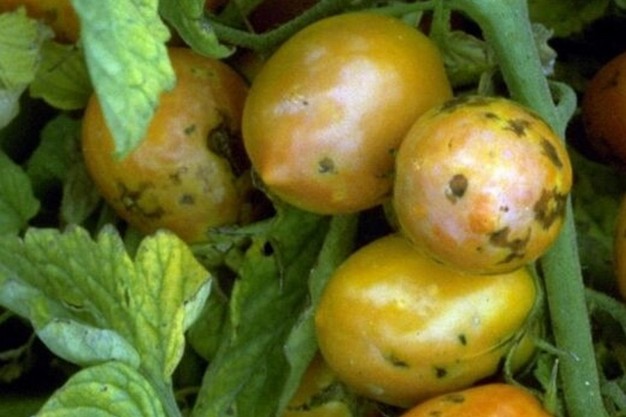Tomato Spotted Wilt Virus (TSWV) is a destructive pathogen belonging to the Tospovirus genus. It was first identified in the early 1900s and has since emerged as a major threat to various crops, including tomatoes, peppers, lettuce, and ornamental plants.
TSWV is primarily spread by thrips, small insect vectors that feed on infected plants and transfer the virus to healthy ones. Once infected, plants suffer significant damage, resulting in yield losses and reduced crop quality.
Symptoms of TSWV in plants
Identifying Tomato Spotted Wilt Virus (TSWV) early can help minimize its impact. Common symptoms include chlorotic or necrotic spots, which appear as yellow or brown patches on leaves, and ring patterns that manifest as concentric designs on leaves or fruits. Additionally, leaf deformation may occur, resulting in twisted or curled leaves with discoloration. Infected plants may also exhibit stunted growth, characterized by reduced plant height and delayed flowering.
 © Trust Seeds
© Trust Seeds
These symptoms vary by crop, making expert diagnosis essential for proper management.
Impact of TSWV on agriculture
The economic and agricultural consequences of Tomato Spotted Wilt Virus (TSWV) include reduced crop yields, as affected plants produce fewer fruits and seeds. There is also a decline in quality, with marketable produce often being deformed or discolored. Additionally, farmers face increased costs due to higher expenses for pest control and disease management.
TSWV's ability to infect over 1,000 plant species exacerbates its impact, making it a pressing concern for global agriculture.
Managing TSWV: An integrated approach
Controlling Tomato Spotted Wilt Virus (TSWV) requires a combination of strategies. Thrips management is crucial and involves using insecticides, biological controls, and sticky traps to reduce thrip populations. Cultural practices also play a significant role, such as removing infected plants, managing weeds, and practicing crop rotation. Additionally, incorporating TSWV resistance genes into susceptible crops is an effective strategy for enhancing genetic resistance.
Among these, genetic resistance offers the most sustainable and long-term solution, aligning with Trust Seeds' mission to empower farmers with resilient crops.
The science behind TSWV resistance genes
Resistance genes are genetic components that enable plants to detect and defend against specific pathogens, including TSWV. These genes are incorporated into crop varieties through traditional breeding or advanced biotechnological techniques.
Key TSWV resistance genes
Tsw Gene: Used extensively in pepper breeding, the Tsw gene provides robust resistance to TSWV by initiating a hypersensitive response (HR). This process limits the virus's ability to spread within the plant.
Sw-5 Gene: The Sw-5 gene is a game-changer for tomato breeding. It offers broad-spectrum resistance by recognizing specific viral proteins and activating defense mechanisms.
RNA-Based Strategies: Innovative approaches, such as RNA interference (RNAi), are being explored to provide targeted resistance by silencing the virus's ability to replicate.
Trust seeds: Advancing TSWV resistance in crops
Trust Seeds is dedicated to delivering high-performance seeds that combine productivity with resilience. Their approach to breeding TSWV-resistant cultivars includes several strategies. In germplasm screening, they identify and select parent plants with strong natural resistance to TSWV. Through marker-assisted selection (MAS), they use advanced DNA marker technologies to pinpoint resistance genes like Tsw and Sw-5, which accelerates the breeding process. All of their TSWV-resistant seeds undergo rigorous testing, including extensive field trials, to ensure they perform well under diverse conditions. Trust Seeds offers farmer-centric solutions, tailoring their seeds to meet the specific needs of farmers by providing high yields and exceptional disease resistance.
For more information:
Trust Seeds
trustseeds.com/
